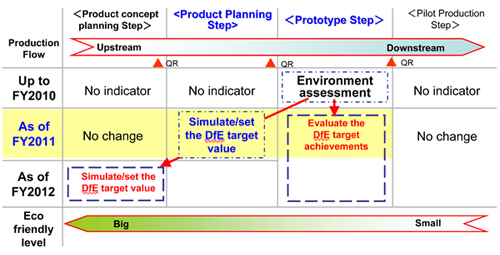Reference
- Toward reducing environmental impacts -
Updated "Automated LCA Calculation System"
with the additions such as LIME, NOx, and SOx!
December. 20, 2011
FUJITSU TEN LIMITED
 |
FUJITSU TEN (Kobe City, Hyogo, Japan; President & Representative Director:
Takashi Shigematsu; Capital: \5.3 billion), developer of the ECLIPSE brand
of car navigation systems, has updated its Life Cycle Assessment (LCA) Automated Calculation System. This system makes quantitative calculations of environmentally hazardous substances at each stage in a product's life cycle, from the extraction of raw materials to the manufacture, distribution, use, and disposal of products.
Beginning in November 2011, it is now possible to calculate the emission of important environmental indicators(*1) in addition to CO2, such as NOx (nitrogen oxides), SOx (sulfur oxides), and LIME(*2). This update has been available since December.
Top calculation speed in the car navigation industry even before update!
The FUJITSU TEN LCA Automated Calculation System, a unique system developed with FUJITSU TEN resources, received the "Incentive Award" from the Life Cycle Assessment Society of Japan(*3) in December 2010 in recognition of its processing efficiency. This system update expands the range of items that are calculated. (See above.)
By simply entering a minimal amount of information, such as product number and manufacturing location, this system can acquire the required data from existing in-house information systems. The result is a major reduction in processing from data entry to calculation.
For example, processing for car navigation systems is reduced on average from 20 hours to 5 minutes. This is the shortest amount of time required for calculation in the car navigation industry. With this significant reduction in calculation processing and the rapid output of required values, more time can now be dedicated to environmentally-friendly design.
Further, this system can be used for all product lines, and not only car navigation systems.
Future updates will include the development of analysis and simulation functionality based on our base model, in order to develop products that are even more environmentally friendly.
"All Green" - Developing Environmentally-Friendly Products with Unique Systems -
 |
||
| DfE:Design for Environment | ||
| "Design for Environment" aims to reduce environmental impacts as much as possible at the planning stage before the full details of a product are completely determined, for the purpose of reducing environmental impacts across the entire life cycle of all products. | ||
Since the 1990s, the FUJITSU TEN Group has introduced a variety of innovations for developing "green products" to reduce environmental impacts.
Before trial production, environmental assessments(*4) have been performed to evaluate the extent of consideration for the environment. Further, in 2010 the LCA Calculation System, Environmental Efficiency Factor Calculation System(*5), and Green Assessment System(*6) were developed to enhance such assessments.
However, since the assessment process up to this time had come to an end before trial production, only actual values were confirmed and there was no clear process for setting target values. To solve this issue, the process has been revised to allow the introduction of assessments at the product planning stage in order to set target values for each product.
Since drawings are not complete and parts and materials have not been specified at the product planning stage, such calculations have not been possible with previous assessment methods. In order to overcome this issue, previous LCA results for FUJITSU TEN products were analyzed, and the primary elements with results that have a significant impact at the product planning stage, such as power consumption, were specified. Then, in May 2011, a mechanism was devised to use these results to estimate LCA values. This mechanism allows the introduction of development targets (results) earlier in the development process.
Development of a DfE Task Management System
Further, a DfE Task Management System was developed in May 2011 to check whether the assessments performed with the LCA Calculation System, Environmental Efficiency Factor Calculation System, and Green Assessment System at each stage throughout development (see above) have been implemented according to schedule (assessment, approval, registration).
Contributing to a Sustainable Society
As part of its "Make everything Green" slogan, the FUJITSU TEN Group has stipulated "super green product development" and a target environmental efficiency factor of 1.7 times as stipulated in its "6th Environmental Action Plan". The development of environmentally-friendly products that are energy-saving, compact, and lightweight is progressing according to plan, as we contribute to the achievement of a sustainable society.
Notes
NOx (nitrogten oxide), SOx (sulfur oxide), BOD (biochemical oxygen demand), COD (chemical oxygen demand), SS (suspended solids), T-N (total nitrogen), TP (total phosphorous), LIME (Life-cycle Impact assessment Method based on Endpoint modeling)
(*2) LIME:Life-cycle Impact assessment Method based on Endpoint modeling
Japanese method for comprehensive environmental impact assessment, developed by the National Institute of Advanced Industrial Science and Technology. Framework for calculating and comparing the weight between different indicators, such as CO2 and NOx, using monetary value (¥) as a common indicator.
(*3) 7th Meeting of the Life Cycle Assessment Society of Japan
The Life Cycle Assessment Society of Japan (JLCA) is a society of members involved in the LCA industry, academia, and national research institutes for the purpose of fulfilling the role of a domestic LCA information center. The 7th meeting of the Life Cycle Assessment Society of Japan was held in December 2010.
(Click here) to read the press release for the 7th JLCA Incentive Award:
(*4) Product environmental assessment
Mechanism for assessing environmental responsiveness before mass production, such as compliance with law and the conservation of energy and resources.
(*5) Environmental Efficiency Factor Calcuation System (discontinued in May 2010)
System for the automatic calculation of indicators for increasing environmental efficiency, by improving the provided value (functionality/performance) of products while reducing environmental impacts.
(*6) Green Assessment System (discontinued in June 2010)
System that incorporates quantitative assessment indicators such as LCA and environmental efficiency factors into conventional assessment indicators, which include improvement of energy conservation, compactness, weight reduction, and recycling. Such indicators are incorporated ahead of compliance (regulations on substances of environmental concern ).
FUJITSU TEN LIMITED(Kobe, Hyogo prefecture, Japan; Capital: 5.3 billion yen), established in 1972 with investment from FUJITSU LIMITED, TOYOTA MOTOR CORPORATION, and DENSO CORPORATION, is a leading manufacturer of automotive electronic equipment. It is a globally-recognized manufacturer of car navigation and audio systems, ECU for engine and airbag control, and mobile communication equipment. Consolidated sales totaled 269 billion yen(US$3.2 billion) for the fiscal year ending March 31, 2011.
FUJITSU TEN is involved in the development of systems that use sensor technologies such as cameras and millimeter wave radar to detect obstacles near automobiles. It is expanding its business globally by fulfilling orders for genuine products for Toyota and other automobile manufactures both domestically and overseas.
The ECLIPSE brand of car navigation and audio products receives high evaluations in various markets throughout the world.
The integrated AVN (Audio Visual Navigation) system, first introduced in 1997, has become the standard format for car navigation systems.
FUJITSU TEN will continue to build a business that "connects" automobiles with society, by integrating its superior automotive technology with ICT technology from the FUJITSU Group.
For more information, see http://www.fujitsu-ten.com/.
[Inquiries from the press]
Corporate Communications Dept.
FUJITSU TEN LIMITED
E-mail:pr@ten.fujitsu.com
TEL: +81-78-682-2170
The contents of a press release are as of the publication. Later, they are apt to be changed without notice. Thank you for understanding in advance.

